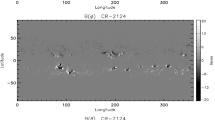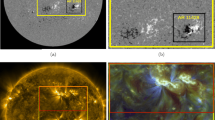Abstract
The Helioseismic and Magnetic Imager (HMI) on board the Solar Dynamics Observatory (SDO) provides photospheric vector magnetograms with a high spatial and temporal resolution. Our intention is to model the coronal magnetic field above active regions with the help of a nonlinear force-free extrapolation code. Our code is based on an optimization principle and has been tested extensively with semianalytic and numeric equilibria and applied to vector magnetograms from Hinode and ground-based observations. Recently we implemented a new version which takes into account measurement errors in photospheric vector magnetograms. Photospheric field measurements are often affected by measurement errors and finite nonmagnetic forces inconsistent for use as a boundary for a force-free field in the corona. To deal with these uncertainties, we developed two improvements: i) preprocessing of the surface measurements to make them compatible with a force-free field, and ii) new code which keeps a balance between the force-free constraint and deviation from the photospheric field measurements. Both methods contain free parameters, which must be optimized for use with data from SDO/HMI. In this work we describe the corresponding analysis method and evaluate the force-free equilibria by how well force-freeness and solenoidal conditions are fulfilled, by the angle between magnetic field and electric current, and by comparing projections of magnetic field lines with coronal images from the Atmospheric Imaging Assembly (SDO/AIA). We also compute the available free magnetic energy and discuss the potential influence of control parameters.






Similar content being viewed by others
Notes
Preprocessing of inconsistent boundary data is particularly important for methods using the magnetic field vector directly as a boundary condition. Grad–Rubin methods use the normal magnetic field and electric current (for one polarity) as the boundary condition. The vertical current is derived from the transverse magnetic field, and these conditions are per construction well posed, even if the photospheric magnetic field vector is not force-free. Consequently, preprocessing is not crucial for these methods.
The values refer to other active regions and dates and are meant as examples of the typical value range for a particular instrument. It is planned to compare vector magnetograms for one particular active region and time observed with different instruments (SOLIS and HMI) and the corresponding force-free models (Thalmann et al., in preparation). Further investigations are necessary to clarify whether the good fulfillment of the force-free consistency criteria here is a property of this particular active region or if the HMI measurements are generally more force-free.
For convenience the values in the last three columns in Table 2 have been multiplied by 105 and rounded to obtain three-figure integer numbers.
References
Alissandrakis, C.E.: 1981, Astron. Astrophys. 100, 197.
Aly, J.J.: 1989, Solar Phys. 120, 19.
Aly, J.J.: 2005, Astron. Astrophys. 429, 15. doi: 10.1051/0004-6361:20041547 .
Amari, T., Aly, J.-J.: 2010, Astron. Astrophys. 522, A52. doi: 10.1051/0004-6361/200913058 .
Amari, T., Boulmezaoud, T.Z., Aly, J.J.: 2006, Astron. Astrophys. 446, 691. doi: 10.1051/0004-6361:20054076 .
Amari, T., Aly, J.J., Luciani, J.F., Boulmezaoud, T.Z., Mikic, Z.: 1997, Solar Phys. 174, 129.
Bineau, M.: 1972, Commun. Pure Appl. Math. 25, 77.
Borrero, J.M., Tomczyk, S., Kubo, M., Socas-Navarro, H., Schou, J., Couvidat, S., Bogart, R.: 2011, Solar Phys. 273, 267. doi: 10.1007/s11207-010-9515-6 .
Boulmezaoud, T.Z., Amari, T.: 2000, Z. Angew. Math. Phys. 51, 942.
Calabretta, M.R., Greisen, E.W.: 2002, Astron. Astrophys. 395, 1077. doi: 10.1051/0004-6361:20021327 .
Conlon, P.A., Gallagher, P.T.: 2010, Astrophys. J. 715, 59. doi: 10.1088/0004-637X/715/1/59 .
DeRosa, M.L., Slater, G.: 2011, http://www.lmsal.com/sdouserguide.html
DeRosa, M.L., Schrijver, C.J., Barnes, G., Leka, K.D., Lites, B.W., Aschwanden, M.J., Amari, T., Canou, A., McTiernan, J.M., Régnier, S., Thalmann, J.K., Valori, G., Wheatland, M.S., Wiegelmann, T., Cheung, M.C.M., Conlon, P.A., Fuhrmann, M., Inhester, B., Tadesse, T.: 2009, Astrophys. J. 696, 1780. doi: 10.1088/0004-637X/696/2/1780 .
Gary, G.A., Hagyard, M.J.: 1990, Solar Phys. 126, 21.
Hagino, M., Sakurai, T.: 2004, Publ. Astron. Soc. Japan 56, 831.
Leka, K.D., Barnes, G., Crouch, A.D., Metcalf, T.R., Gary, G.A., Jing, J., Liu, Y.: 2009, Solar Phys. 260, 83. doi: 10.1007/s11207-009-9440-8 .
Lemen, J.R., Title, A.M., Akin, D.J., Boerner, P.F., Chou, C., Drake, J.F., Duncan, D.W., Edwards, C.G., Friedlaender, F.M., Heyman, G.F., Hurlburt, N.E., Katz, N.L., Kushner, G.D., Levay, M., Lindgren, R.W., Mathur, D.P., McFeaters, E.L., Mitchell, S., Rehse, R.A., Schrijver, C.J., Springer, L.A., Stern, R.A., Tarbell, T.D., Wuelser, J.-P., Wolfson, C.J., Yanari, C., Bookbinder, J.A., Cheimets, P.N., Caldwell, D., Deluca, E.E., Gates, R., Golub, L., Park, S., Podgorski, W.A., Bush, R.I., Scherrer, P.H., Gummin, M.A., Smith, P., Auker, G., Jerram, P., Pool, P., Soufli, R., Windt, D.L., Beardsley, S., Clapp, M., Lang, J., Waltham, N.: 2012, Solar Phys. 275, 17. doi: 10.1007/s11207-011-9776-8 .
Metcalf, T.R.: 1994, Solar Phys. 155, 235.
Metcalf, T.R., Leka, K.D., Barnes, G., Lites, B.W., Georgoulis, M.K., Pevtsov, A.A., Balasubramaniam, K.S., Gary, G.A., Jing, J., Li, J., Liu, Y., Wang, H.N., Abramenko, V., Yurchyshyn, V., Moon, Y.-J.: 2006, Solar Phys. 237, 267. doi: 10.1007/s11207-006-0170-x .
Metcalf, T.R., DeRosa, M.L., Schrijver, C.J., Barnes, G., van Ballegooijen, A.A., Wiegelmann, T., Wheatland, M.S., Valori, G., McTiernan, J.M.: 2008, Solar Phys. 247, 269. doi: 10.1007/s11207-007-9110-7 .
Molodensky, M.M.: 1969, Soviet Astron. 12, 585.
Molodensky, M.M.: 1974, Solar Phys. 39, 393.
Sakurai, T.: 1989, Space Sci. Rev. 51, 11.
Scherrer, P.H., Schou, J., Bush, R.I., Kosovichev, A.G., Bogart, R.S., Hoeksema, J.T., Liu, Y., Duvall, T.L., Zhao, J., Title, A.M., Schrijver, C.J., Tarbell, T.D., Tomczyk, S.: 2012, Solar Phys. 275, 207. doi: 10.1007/s11207-011-9834-2
Schou, J., Borrero, J.M., Norton, A.A., Tomczyk, S., Elmore, D., Card, G.L.: 2012, Solar Phys. 275, 327. doi: 10.1007/s11207-010-9639-8 .
Schrijver, C.J., DeRosa, M.L., Metcalf, T.R., Liu, Y., McTiernan, J., Régnier, S., Valori, G., Wheatland, M.S., Wiegelmann, T.: 2006, Solar Phys. 235, 161. doi: 10.1007/s11207-006-0068-7 .
Schrijver, C.J., DeRosa, M.L., Metcalf, T., Barnes, G., Lites, B., Tarbell, T., McTiernan, J., Valori, G., Wiegelmann, T., Wheatland, M.S., Amari, T., Aulanier, G., Démoulin, P., Fuhrmann, M., Kusano, K., Régnier, S., Thalmann, J.K.: 2008, Astrophys. J. 675, 1637. doi: 10.1086/527413 .
Tadesse, T., Wiegelmann, T., Inhester, B., Pevtsov, A.: 2011, Astron. Astrophys. 527, A30. doi: 10.1051/0004-6361/201015491 .
Tadesse, T., Wiegelmann, T., Inhester, B., Pevtsov, A.: 2012, Solar Phys. 277, 119. doi: 10.1007/s11207-011-9764-z .
Thalmann, J.K., Wiegelmann, T., Raouafi, N.-E.: 2008, Astron. Astrophys. 488, 71. doi: 10.1051/0004-6361:200810235 .
Turmon, M., Jones, H.P., Malanushenko, O.V., Pap, J.M.: 2010, Solar Phys. 262, 277. doi: 10.1007/s11207-009-9490-y .
Wheatland, M.S., Leka, K.D.: 2011, Astrophys. J. 728, 112. doi: 10.1088/0004-637X/728/2/112 .
Wheatland, M.S., Régnier, S.: 2009, Astrophys. J. Lett. 700, L88. doi: 10.1088/0004-637X/700/2/L88 .
Wheatland, M.S., Sturrock, P.A., Roumeliotis, G.: 2000, Astrophys. J. 540, 1150.
Wiegelmann, T.: 2004, Solar Phys. 219, 87.
Wiegelmann, T.: 2008, J. Geophys. Res. 113, A03S02. doi: 10.1029/2007JA012432 .
Wiegelmann, T., Inhester, B.: 2010, Astron. Astrophys. 516, A107. doi: 10.1051/0004-6361/201014391 .
Wiegelmann, T., Inhester, B., Sakurai, T.: 2006, Solar Phys. 233, 215.
Wiegelmann, T., Lagg, A., Solanki, S.K., Inhester, B., Woch, J.: 2005, Astron. Astrophys. 433, 701.
Acknowledgements
Data are courtesy of NASA/SDO and the AIA and HMI science teams. We are grateful to Marc DeRosa for his help with the AIA data. This work was supported by DLR grant 50 OC 0904 and DFG grant WI 3211/2-1.
Author information
Authors and Affiliations
Corresponding author
Additional information
The Sun 360
Guest Editors: Bernhard Fleck, Bernd Heber, and Angelos Vourlidas
Rights and permissions
About this article
Cite this article
Wiegelmann, T., Thalmann, J.K., Inhester, B. et al. How Should One Optimize Nonlinear Force-Free Coronal Magnetic Field Extrapolations from SDO/HMI Vector Magnetograms?. Sol Phys 281, 37–51 (2012). https://doi.org/10.1007/s11207-012-9966-z
Received:
Accepted:
Published:
Issue Date:
DOI: https://doi.org/10.1007/s11207-012-9966-z




